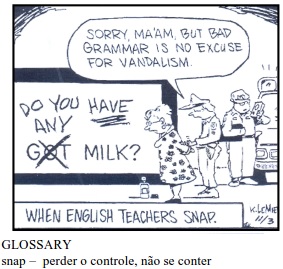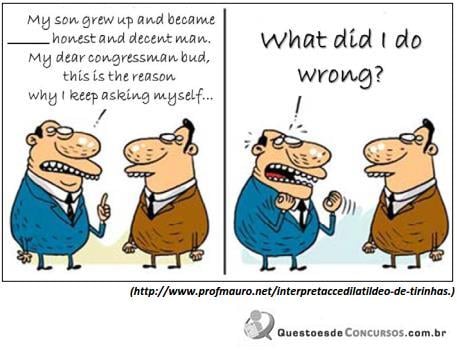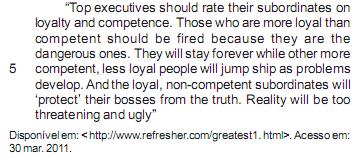Questões Militares Comentadas sobre inglês
Foram encontradas 2.813 questões
What’s in a name?
Henry Louis Gates Jr. (1989)
The question of color takes up much space in these pages, but the question of color, especially in this country, operates to hide the graver questions of the self.
- James Baldwin, 1961
… blood, darky, Tar baby, Kaffir, shine… moor, blackamoor, Jim Crow, spook… quadroon, meriney, red bone, high yellow… Mammy, porch monkey, home, homeboy, George… spearchucker, Leroy, Smokey…mouli, buck, Ethiopian, brother, sistah…
- Trey Ellis, 1989
I had forgotten the incident completely, until I read Trey Elli’s essay, “Remember My Name,” in a recent issue of the Village Voice (June 13, 1989). But there, in the middle of an extended italicized list of the bynames of “the race” (“the race” or “our people” being the terms my parents used in polite or reverential discourse, “jigaboo” or “nigger” more commonly used in anger, jest, or pure disgust), it was: “George”. Now the events of that very brief exchange return to my mind so vividly that I wonder why I had forgotten it.
My father and I were walking home at dusk from his second job. He “moonlighted” as a janitor in the evenings for the telephone company. Every day, but Saturday, he would come home at 3:30 from his regular job at the paper Mill, wash up, eat supper, then at 4:30 head downtown to his second job. He used to make jokes frequently about a union official who moonlighted. I never got the joke, but he and his friends thought it was hilarious. All I knew was that my family always ate well, that my brother and I had new clothes to wear, and that all of the white people in Piedmont, West Virginia, treated my parents with an odd mixture of resentment and respect that even we understood at the time had something directly to do with a small but certain measure of financial security.
He had left a little early that evening because I was with him and I had to be in bed early. I could not have been more than five or six, and we had stopped off at the Cut-Rate Drug Store (where no black person in town but my father could sit down to eat, and eat off real plates with real silverware) so that I could buy some caramel ice cream, two scoops in a wafer cone, please, which I was busy licking when Mr. Wilson walked by.
Mr. Wilson was a very quiet man, whose stony, brooding, silent manner seemed designed to scare off any overtures of friendship, even from white people. He was Irish as was one-third of our village (another third being Italian), the more affluent among whom sent their children to “Catholic School” across the bridge in Maryland. He had white straight hair, like my Uncle Joe, whom he uncannily resembled, and he carried a black worn metal lunch pail, the kind that Riley carried on the television show. My father always spoke to him, and for reasons that we never did understand, he always spoke to my father.
“Hello, Mr. Wilson,” I heard my father say.
“Hello, George.” I stopped licking my ice cream cone, and asked my Dad in a loud voice why Mr. Wilson had called him “George.”
“Doesn’t he know your name, Daddy? Why don’t you tell him your name? Your name isn’t George.”
For a moment I tried to think of who Mr. Wilson was mixing Pop up with. But we didn’t have any Georges among the colored people in Piedmont; nor were there colored Georges living in the neighboring towns and working at the Mill.
“Tell him your name, Daddy.”
“He knows my name, boy,” my father said after a long pause. “He calls all colored people George.” A long silence ensued. It was “one of those things”, as my Mom would put it. Even then, that early, I knew when I was in the presence of “one of those things”, one of those things that provided a glimpse, through a rent curtain, at another world that we could not affect but that affected us. There would be a painful moment of silence, and you would wait for it to give way to a discussion of a black superstar such as Sugar Ray or Jackie Robinson.
“Nobody hits better in a clutch than Jackie Robinson.”
“That’s right. Nobody.”
I never again looked Mr. Wilson in the eye.
What’s in a name?
Henry Louis Gates Jr. (1989)
The question of color takes up much space in these pages, but the question of color, especially in this country, operates to hide the graver questions of the self.
- James Baldwin, 1961
… blood, darky, Tar baby, Kaffir, shine… moor, blackamoor, Jim Crow, spook… quadroon, meriney, red bone, high yellow… Mammy, porch monkey, home, homeboy, George… spearchucker, Leroy, Smokey…mouli, buck, Ethiopian, brother, sistah…
- Trey Ellis, 1989
I had forgotten the incident completely, until I read Trey Elli’s essay, “Remember My Name,” in a recent issue of the Village Voice (June 13, 1989). But there, in the middle of an extended italicized list of the bynames of “the race” (“the race” or “our people” being the terms my parents used in polite or reverential discourse, “jigaboo” or “nigger” more commonly used in anger, jest, or pure disgust), it was: “George”. Now the events of that very brief exchange return to my mind so vividly that I wonder why I had forgotten it.
My father and I were walking home at dusk from his second job. He “moonlighted” as a janitor in the evenings for the telephone company. Every day, but Saturday, he would come home at 3:30 from his regular job at the paper Mill, wash up, eat supper, then at 4:30 head downtown to his second job. He used to make jokes frequently about a union official who moonlighted. I never got the joke, but he and his friends thought it was hilarious. All I knew was that my family always ate well, that my brother and I had new clothes to wear, and that all of the white people in Piedmont, West Virginia, treated my parents with an odd mixture of resentment and respect that even we understood at the time had something directly to do with a small but certain measure of financial security.
He had left a little early that evening because I was with him and I had to be in bed early. I could not have been more than five or six, and we had stopped off at the Cut-Rate Drug Store (where no black person in town but my father could sit down to eat, and eat off real plates with real silverware) so that I could buy some caramel ice cream, two scoops in a wafer cone, please, which I was busy licking when Mr. Wilson walked by.
Mr. Wilson was a very quiet man, whose stony, brooding, silent manner seemed designed to scare off any overtures of friendship, even from white people. He was Irish as was one-third of our village (another third being Italian), the more affluent among whom sent their children to “Catholic School” across the bridge in Maryland. He had white straight hair, like my Uncle Joe, whom he uncannily resembled, and he carried a black worn metal lunch pail, the kind that Riley carried on the television show. My father always spoke to him, and for reasons that we never did understand, he always spoke to my father.
“Hello, Mr. Wilson,” I heard my father say.
“Hello, George.” I stopped licking my ice cream cone, and asked my Dad in a loud voice why Mr. Wilson had called him “George.”
“Doesn’t he know your name, Daddy? Why don’t you tell him your name? Your name isn’t George.”
For a moment I tried to think of who Mr. Wilson was mixing Pop up with. But we didn’t have any Georges among the colored people in Piedmont; nor were there colored Georges living in the neighboring towns and working at the Mill.
“Tell him your name, Daddy.”
“He knows my name, boy,” my father said after a long pause. “He calls all colored people George.” A long silence ensued. It was “one of those things”, as my Mom would put it. Even then, that early, I knew when I was in the presence of “one of those things”, one of those things that provided a glimpse, through a rent curtain, at another world that we could not affect but that affected us. There would be a painful moment of silence, and you would wait for it to give way to a discussion of a black superstar such as Sugar Ray or Jackie Robinson.
“Nobody hits better in a clutch than Jackie Robinson.”
“That’s right. Nobody.”
I never again looked Mr. Wilson in the eye.
Alcohol can increase your risk of being hurt in a car accident, even if you aren't behind the wheel. A new University of Michigan study reports that men who have been drinking are 50 percent more likely to experience a serious injury during a car accident than sober passengers.
According to the text, all the alternatives are correct, except:

“excuse" is closest in meaning to, except:

The word myself refers back to

The item that completes the comic strip is
A mysterious ancient cemetery in Egypt could contain more than a million mummified human remains, archaeologists have claimed.
Around 1,700 bodies have so far been uncovered at the Fag el-Gamous (Way of the Water Buffalo) site, around 60 miles south of Cairo. But experts believe that countless more are contained in the burial ground.
“We are fairly certain we have over a million burials within this cemetery. It's large, and it's dense,” said project director Kerry Muhlestein, an associate professor in the Department of Ancient Scripture at Brigham Young University (BYU), which has been examining the site for around 30 years. They were placed there between the 1st and the 7th centuries AD, but the scale of the site has left many baffled. A nearby village has been deemed too small to warrant such a large cemetery, while the closest major settlements had their own burial grounds.
“It's hard to know where all these people were coming from,” Professor Muhlestein told Live Science.
Another interesting find was that the corpses appeared to be grouped together by hair colour, with one section containing the remains of those with blonde hair and another for those with red hair. The bodies, which included a man of more than seven feet in height, are thought to be of ordinary citizens, rather than the royalty found at many famous Egyptian sites. They were not buried in coffins, according to Muhlestein, and were in fact mummified not by design but by the arid natural environment.
“The people in the cemetery represent the common man. They are the average people who are usually hard to learn about because they are not very visible in written sources. A lot of their wealth, or the little that they had, was poured into these burials.”
His team discovered objects including glassware, jewellery and linen. The findings were presented to the Scholars Colloquim at the Society for the Study of Egyptian Antiquities in Toronto last month.
The Telegraph, London.
(http://www.traveller.com.au/mysterious-ancient-cemetery-in-egypt-could-contain-a-
million-mummies-12aaq7.)
A mysterious ancient cemetery in Egypt could contain more than a million mummified human remains, archaeologists have claimed.
Around 1,700 bodies have so far been uncovered at the Fag el-Gamous (Way of the Water Buffalo) site, around 60 miles south of Cairo. But experts believe that countless more are contained in the burial ground.
“We are fairly certain we have over a million burials within this cemetery. It's large, and it's dense,” said project director Kerry Muhlestein, an associate professor in the Department of Ancient Scripture at Brigham Young University (BYU), which has been examining the site for around 30 years. They were placed there between the 1st and the 7th centuries AD, but the scale of the site has left many baffled. A nearby village has been deemed too small to warrant such a large cemetery, while the closest major settlements had their own burial grounds.
“It's hard to know where all these people were coming from,” Professor Muhlestein told Live Science.
Another interesting find was that the corpses appeared to be grouped together by hair colour, with one section containing the remains of those with blonde hair and another for those with red hair. The bodies, which included a man of more than seven feet in height, are thought to be of ordinary citizens, rather than the royalty found at many famous Egyptian sites. They were not buried in coffins, according to Muhlestein, and were in fact mummified not by design but by the arid natural environment.
“The people in the cemetery represent the common man. They are the average people who are usually hard to learn about because they are not very visible in written sources. A lot of their wealth, or the little that they had, was poured into these burials.”
His team discovered objects including glassware, jewellery and linen. The findings were presented to the Scholars Colloquim at the Society for the Study of Egyptian Antiquities in Toronto last month.
The Telegraph, London.
(http://www.traveller.com.au/mysterious-ancient-cemetery-in-egypt-could-contain-a-
million-mummies-12aaq7.)
A mysterious ancient cemetery in Egypt could contain more than a million mummified human remains, archaeologists have claimed.
Around 1,700 bodies have so far been uncovered at the Fag el-Gamous (Way of the Water Buffalo) site, around 60 miles south of Cairo. But experts believe that countless more are contained in the burial ground.
“We are fairly certain we have over a million burials within this cemetery. It's large, and it's dense,” said project director Kerry Muhlestein, an associate professor in the Department of Ancient Scripture at Brigham Young University (BYU), which has been examining the site for around 30 years. They were placed there between the 1st and the 7th centuries AD, but the scale of the site has left many baffled. A nearby village has been deemed too small to warrant such a large cemetery, while the closest major settlements had their own burial grounds.
“It's hard to know where all these people were coming from,” Professor Muhlestein told Live Science.
Another interesting find was that the corpses appeared to be grouped together by hair colour, with one section containing the remains of those with blonde hair and another for those with red hair. The bodies, which included a man of more than seven feet in height, are thought to be of ordinary citizens, rather than the royalty found at many famous Egyptian sites. They were not buried in coffins, according to Muhlestein, and were in fact mummified not by design but by the arid natural environment.
“The people in the cemetery represent the common man. They are the average people who are usually hard to learn about because they are not very visible in written sources. A lot of their wealth, or the little that they had, was poured into these burials.”
His team discovered objects including glassware, jewellery and linen. The findings were presented to the Scholars Colloquim at the Society for the Study of Egyptian Antiquities in Toronto last month.
The Telegraph, London.
(http://www.traveller.com.au/mysterious-ancient-cemetery-in-egypt-could-contain-a-
million-mummies-12aaq7.)

According to this cartoon, penguins are sort of responsible for

The expression “jump ship” (l. 5) should be understood as

Considering how subordinates should be rated, the text says that
“The first rule of any technology used in a business is that automation applied to an efficient operation will magnify the efficiency. The second is that automation applied to an inefficient operation will magnify the inefficiency.”
GATES, Bill. The first...Disponível em: < http://www.refresher.com/ wwvol1.html >. Acesso em: 30 mar. 2011.
According to the text, automation contributes to